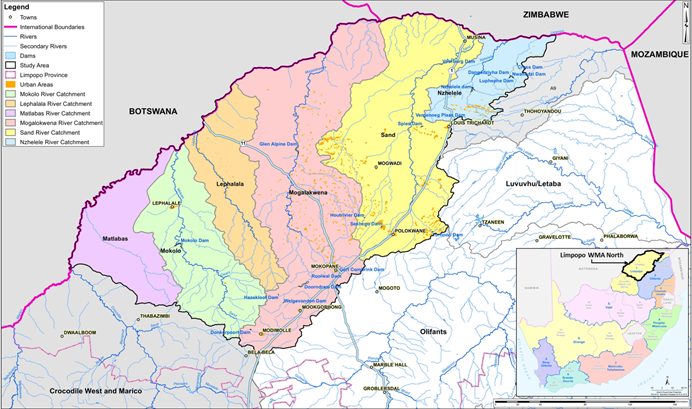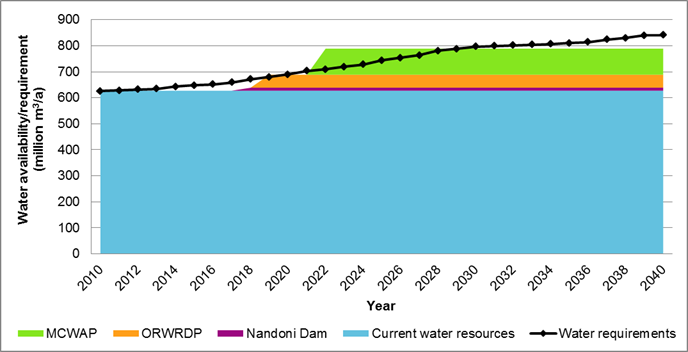|
STRATEGY AREA
Awaiting Information from Customer
The area under investigation for this Reconciliation Strategy is the Limpopo WMA,
as defined in the First Edition of the National Water Resource Strategy (NWRS-1, 2004) and
also referred to as the Limpopo WMA North – refer to the figure below. Although the Crocodile (West),
Marico and Luvuvhu catchments were consolidated in the Limpopo WMA as per the Second Edition of the National Water Resource Strategy (NWRS-2, 2012),
reconciliation strategies for these additional areas have been undertaken.
The Luvuvhu River system is included in the Reconciliation Strategy for the Luvuvhu and Letaba Water Supply System (completed in 2015), and
the Reconciliation Strategy for the Crocodile West Water Supply System which has progressed to the implementation and maintenance phase. However,
cognisance of the Luvuvhu and the Crocodile West catchments, as well as the adjacent Letaba and Olifants catchments were taken,
as water is transferred from these catchments to the Limpopo WMA North.

Study Area for the Limpopo WMA North Reconciliation Strategy
The study area comprises of the major catchments of the Limpopo WMA North namely Matlabas, Mokolo, Lephalala, Mogalakwena, Sand and Nzhelele and covers the tertiary drainage regions A41, A42, A50, A61 to A63, A71, A72 and A80. These rivers form part of the Limpopo River Basin, which is shared by South Africa, Botswana, Zimbabwe and Mozambique.
Urban centres within the Study Area include Lephalale, Modimolle, Mookgopong, Mokopane, Polokwane, Louis Trichardt and Musina. Economic activities are mainly irrigation and livestock farming as well as power generation and increasing mining operations due to the vast untapped mining potential in the area.
Sources of water
The water resources, especially surface water resources, are stressed due to extensive development in most of the six catchments. The largest dam in the Limpopo WMA North is the Mokolo Dam, which is used for irrigation and water supply to the Matimba Power Station, the associated Grootegeluk Coal Mine and Lephalale Town. Other major dams are Doorndraai Dam, Glen Alpine Dam, Nzhelele Dam, Mutshedzi Dam, and the Nwanedi and Luphephe twin dams. Groundwater contributes approximately 40% towards the yield from local resources and is the only dependable water source for the majority of rural domestic users in the WMA. Transfers from the Olifants, Luvuvhu/Letaba and the Crocodile (West) and Marico WMAs augment supply to Mokopane, Polokwane and Louis Trichardt.
The graph below shows the water balance for the Study Area, including planned additional water resources which are currently in the final design stages or which are being constructed. Refer to the Study Area page for more information regarding the supply areas, the sources of water and planned future developments in each catchment.

Water balance for the Limpopo WMA North
PLANNING FOR SUSTAINABLE WATER SUPPLY
The objective of this study is to formulate a water resource reconciliation strategy for the entire Limpopo WMA North up to 2040. The Strategy will:
- address growing water requirements as well as water quality problems experienced in the catchment;
- identify potential resource development options and
- provide reconciliation interventions, both structural and administrative/ regulatory.
Tasks included in the preparation of the Strategy include hydrological analyses, current and future water requirements and return flows, water conservation and demand management (WCWDM), opportunities for water reuse, invasive alien plants, assessment of water quality, scenarios for Reserve requirements and utilisation of groundwater, international obligations, modelling of yield analyses (WRYM), water quality (WQT) and planning analyses (WRPM), review schemes and update of cost estimates, assessment of social and environmental impacts, formulation of scenarios, stakeholder engagement and public participation as well as training and capacity building.
With limited potential extra surface water availability, the potential of future groundwater development will also be considered as one of the potential future augmentation options, provided that the water quality is of acceptable quality. Some of the sub-catchments in the study area are already in deficit and compulsory licensing might have to be introduced.
The reconciliation strategy has Planning Objectives to reconcile future water requirements with water supply for a 25-year planning horizon up to 2040, and to provide a framework for decision-making with regard to both securing supply and managing the water requirements. A Study Steering Committee (SSC) has been established to guide the development of the Limpopo WMA North Reconciliation Strategy.
For more detail please refer to the Steering Committee, Stakeholder Engagement, and Reports & Documents pages.
STUDY STEERING COMMITTEE
A Study Steering Committee (SSC) comprising key role-players and decision-makers has been established to oversee and guide the process to develop the Limpopo WMA North Reconciliation Strategy. The inaugural meeting was held on 18 February 2015. Members of the SSC represent all provincial government departments involved in water resources management, the DWS National and Limpopo Regional Offices, District and Local Municipalities, Water Boards and Water User Associations, agriculture, industries and mines as well as conservation organisations and academic institutions.
The SSC will be a voluntary body operating at a strategic level and ensuring that the technical aspect of the Study is transparent, open and consultative and that cooperative governance is embraced.
The Reconciliation Strategy will be developed as the first phase, which will be followed by a second (continuation) phase to put in place arrangements and resources for the on-going maintenance of the reconciliation strategy and enabling its implementation. In the continuation phase the Reconciliation Strategy will be updated regularly, keeping the 25 year time horizon, adapting to the changing situation and incorporating new information as it becomes available. It is envisaged that the SSC will be transformed into a Strategy Steering Committee at the end of the first phase of the Study. The role of the Strategy Steering Committee will shift towards maintaining the Reconciliation Strategy and monitoring the implementation of the Reconciliation Strategy on a continuous basis.
|